Direct Position Determination of Wideband Source over Multipath Environment: Combining Taylor Expansion and Subspace Data Fusion in the Cross-Spectrum Domain
Abstract
1. Introduction
- We construct the data model based on the cross-spectrum between received signals from any pair of sensors. This method fully extracts the position information from the received signals, thereby avoiding any loss of available information, and can be effectively applied to high-resolution models. Moreover, we further use forward spatial smoothing to address the issue of covariance matrix rank deficiency in multipath environments.
- We offer a cost function based on forward spatial smooth and subspace data fusion to obtain the initial estimation, and then first-order Taylor expansion is employed to obtain off-grid compensation on the initial estimation, enhancing the localization performance for emitters that do not lie on the search grid.
- We have evaluated the performance of our algorithm across multiple circumstances using comprehensive simulation studies and actual experiments. The results of these simulations demonstrate our algorithm’s remarkable efficacy and adaptability, underscoring its significant potential for application in multipath environments.
2. Signal Model
3. Pre-Procesing in the Cross-Spectrum Domain
4. The Proposed Algorithm
4.1. Forward Spatial Smoothing Process
4.2. Subspace Data Fusion
4.3. Taylor Expansion
- Select the reference signal based on the prior information and segment the signals received by each sensor.
- According to Equation (4), compute the cross-correlation between any two sensors and obtain the cross-spectrum by applying the DFT.
5. Performance Analysis
5.1. Complexity Analysis
5.2. Effectiveness of the Proposed Algorithm
5.3. Advantage of the Proposed Algorithm
6. Experiment Result
7. Conclusions
Author Contributions
Funding
Institutional Review Board Statement
Data Availability Statement
Conflicts of Interest
Abbreviations
| DPD | Direct Position Determination |
| DOA | Directory of Arrival |
| TOA | Time of Arrival |
| TDOA | Time Difference in Arrival |
| RSS | Received Signal Strength |
| FDOA | Frequency Difference in Arrival |
| LS | Least Square |
| ML | Maximum Likelihood |
| SDF | Subspace Data Fusion |
| MUSIC | Multiple Signal Classification |
| MVDP | Minimum Variance Distortionless Response |
| QPSO | Quantum-behaved Particle Swarm Optimization |
| MDF | Multi-array Data Fusion |
| SNR | Signal-to-Noise Ratio |
| OWLS | Optimal Weighted Lest Square |
| FIM | Fisher Information Matrix |
| CRB | Cramér–Rao Bound |
| LFM | Linear Frequency Modulation |
| STFT | Short-Time Fourier Transform |
| HT | Hough Transform |
| MFF | Multiple-frequency Function Fusion |
| PARAFAC | Parallel Factor |
References
- Subedi, S.; Zhang, Y.D.; Amin, M.G.; Himed, B. Group sparsity based multi-target tracking in passive multi-static radar systems using Doppler-only measurements. IEEE Trans. Signal Process. 2016, 64, 3619–3634. [Google Scholar] [CrossRef]
- Tang, Z.; Manikas, A. Multi direction-of-arrival tracking using rigid and flexible antenna arrays. IEEE Trans. Wirel. Commun. 2021, 20, 7568–7580. [Google Scholar] [CrossRef]
- Chervoniak, Y.; Sinitsyn, R.; Yanovsky, F.; Zaporozhets, O. TDOA and Doppler Shift Estimation Method for Passive Acoustic Location of Flying Vehicles. In Proceedings of the 2018 IEEE 17th International Conference on Mathematical Methods in Electromagnetic Theory (MMET), Kyiv, Ukraine, 2–5 July 2018; IEEE: New York, NY, USA, 2018; pp. 119–122. [Google Scholar]
- Ye, H.; Yang, B.; Long, Z.; Dai, C. A method of indoor positioning by signal fitting and PDDA algorithm using BLE AOA device. IEEE Sens. J. 2022, 22, 7877–7887. [Google Scholar] [CrossRef]
- Shen, J.; Molisch, A.F.; Salmi, J. Accurate passive location estimation using TOA measurements. IEEE Trans. Wirel. Commun. 2012, 11, 2182–2192. [Google Scholar] [CrossRef]
- Li, Q.; Chen, B.; Yang, M. Improved two-step constrained total least-squares TDOA localization algorithm based on the alternating direction method of multipliers. IEEE Sens. J. 2020, 20, 13666–13673. [Google Scholar] [CrossRef]
- Kim, D.G.; Park, G.H.; Kim, H.N.; Park, J.O.; Park, Y.M.; Shin, W.H. Computationally efficient TDOA/FDOA estimation for unknown communication signals in electronic warfare systems. IEEE Trans. Aerosp. Electron. Syst. 2017, 54, 77–89. [Google Scholar] [CrossRef]
- Li, X. RSS-based location estimation with unknown pathloss model. IEEE Trans. Wirel. Commun. 2006, 5, 3626–3633. [Google Scholar] [CrossRef]
- You, M.Y.; Lu, A.N.; Ye, Y.X.; Huang, K.; Lou, C. Direct Position Determination Using Compressive Sensing Measurements without Reconstruction. IEEE Trans. Aerosp. Electron. Syst. 2022, 59, 2036–2043. [Google Scholar] [CrossRef]
- Weiss, A.J. Direct position determination of narrowband radio frequency transmitters. IEEE Signal Process. Lett. 2004, 11, 513–516. [Google Scholar] [CrossRef]
- Demissie, B.; Oispuu, M.; Ruthotto, E. Localization of multiple sources with a moving array using subspace data fusion. In Proceedings of the 2008 11th International Conference on Information Fusion, Cologne, Germany, 30 June–3 July 2008; IEEE: New York, NY, USA, 2008; pp. 1–7. [Google Scholar]
- Schmidt, R. Multiple emitter location and signal parameter estimation. IEEE Trans. Antennas Propag. 1986, 34, 276–280. [Google Scholar] [CrossRef]
- Tzafri, L.; Weiss, A.J. High-resolution direct position determination using MVDR. IEEE Trans. Wirel. Commun. 2016, 15, 6449–6461. [Google Scholar] [CrossRef]
- Yuanchun Tang, R.C.; Xia, B. Direct positioning method of interference source of satellite navigation system based on propagation operator. J. Terahertz Sci. Electron. Inf. Technol. 2023, 21, 985–991. [Google Scholar]
- Huang, Z.; Wu, J. Multi-array data fusion based direct position determination algorithm. In Proceedings of the 2014 Seventh International Symposium on Computational Intelligence and Design, Hangzhou, China, 13–14 December 2014; IEEE: New York, NY, USA, 2014; Volume 2, pp. 121–124. [Google Scholar]
- Sun, Y.; Zhang, X.; Shi, X. Direct Position Determination Algorithm for Multiple Arrays via Weighted Propagator Method. China Commun. 2022, 1–13. [Google Scholar] [CrossRef]
- Shi, X.; Zhang, X.; Qian, Y.; Ahmad, M. Closed-form rectilinear emitters localization with multiple sensor arrays: Phase alignment and optimal weighted least-square method. IEEE Sens. J. 2023, 23, 7266–7278. [Google Scholar] [CrossRef]
- Vankayalapati, N.; Kay, S.; Ding, Q. TDOA based direct positioning maximum likelihood estimator and the Cramer-Rao bound. IEEE Trans. Aerosp. Electron. Syst. 2014, 50, 1616–1635. [Google Scholar] [CrossRef]
- Chen, F.; Zhou, T.; Yi, W.; Kong, L.; Zhai, B. Passive direct position determination of multiple emitters transmitting unknown LFM signals. In Proceedings of the 2018 IEEE Radar Conference (RadarConf18), Oklahoma City, OK, USA, 23–27 April 2018; IEEE: New York, NY, USA, 2018; pp. 1129–1133. [Google Scholar]
- Hao, K.; Wan, Q. An efficiency-improved TDOA-based direct position determination method for multiple sources. In Proceedings of the ICASSP 2019—2019 IEEE International Conference on Acoustics, Speech and Signal Processing (ICASSP), Brighton, UK, 12–17 May 2019; IEEE: New York, NY, USA, 2019; pp. 4425–4429. [Google Scholar]
- Zhu, K.; Jiang, H.; Yu, L.; Li, Y.; Li, J. An Improved TDOA-based DPD Method via Multiple-frequency Function Fusion. In Proceedings of the 2022 7th International Conference on Signal and Image Processing (ICSIP), Suzhou, China, 20–22 July 2022; IEEE: New York, NY, USA, 2022; pp. 217–221. [Google Scholar]
- Li, J.; Li, Y.; Jiang, H.; Zhang, X.; Wu, Q. Multi-TDOA estimation and source direct position determination based on parallel factor analysis. IEEE Internet Things J. 2022, 10, 7405–7415. [Google Scholar] [CrossRef]
- Li, D.; Li, J.; You, M.; Tang, W.; Zhang, X.; Qin, W. Direct localization of wideband sources using distributed arrays: A subspace focusing and dimension reduction approach. Signal Process. 2025, 232, 109902. [Google Scholar] [CrossRef]
- Piccinni, G.; Avitabile, G.; Coviello, G.; Talarico, C. Real-time distance evaluation system for wireless localization. IEEE Trans. Circuits Syst. I Regul. Pap. 2020, 67, 3320–3330. [Google Scholar] [CrossRef]
- Li, S.; Qi, C.; Zhang, Y. A low computation direct position determination based on TDOA. In Proceedings of the 2021 3rd International Academic Exchange Conference on Science and Technology Innovation (IAECST), Guangzhou, China, 10–12 December 2021; IEEE: New York, NY, USA, 2021; pp. 63–67. [Google Scholar]
- Qi, S.R.; Yuan, C.S.; Liang, B.J.; Lu, G.; Hu, L.; Heng, S. A direct position determination method for four-station TDOA location system. In Proceedings of the 2019 IEEE International Conference on Signal, Information and Data Processing (ICSIDP), Chongqing, China, 11–13 December 2019; IEEE: New York, NY, USA, 2019; pp. 1–5. [Google Scholar]
- Ma, F.; Liu, Z.M.; Guo, F. Direct position determination in asynchronous sensor networks. IEEE Trans. Veh. Technol. 2019, 68, 8790–8803. [Google Scholar] [CrossRef]
- Zhong, S.; Xia, W.; Song, J.; He, Z. Super-resolution time delay estimation in multipath environments using normalized cross spectrum. In Proceedings of the 2013 International Conference on Communications, Circuits and Systems (ICCCAS), Chengdu, China, 15–17 November 2013; IEEE: New York, NY, USA, 2013; Volume 1, pp. 288–291. [Google Scholar]
- Ge, F.X.; Shen, D.; Peng, Y.; Li, V.O. Super-resolution time delay estimation in multipath environments. IEEE Trans. Circuits Syst. I Regul. Pap. 2007, 54, 1977–1986. [Google Scholar] [CrossRef]
- Li, J.; Li, P.; Li, P.; Tang, L.; Zhang, X.; Wu, Q. Self-position awareness based on cascade direct localization over multiple source data. IEEE Trans. Intell. Transp. Syst. 2022, 25, 796–804. [Google Scholar] [CrossRef]
- Liu, Y.; Shi, X. DPD of NC signals with multiple base stations: Reduced Dimension Propagator Method and Taylor compensation. J. Terahertz Sci. Electron. Inf. Technol. 2023, 21, 725–733. [Google Scholar]
- Chen, K.; Chen, W.; Li, J. Noncircular Distributed Source DOA Estimation with Nested Arrays via Reduced-Dimension MUSIC. Sensors 2024, 24, 6653. [Google Scholar] [CrossRef] [PubMed]
- Gao, Y.; Zhang, X.; You, M.; Pan, H.; Mao, S.; Jiang, K.; Li, J. Direct Self-Position Determination Exploiting Multiple Non-circular Emitters: A Reduced Dimensional Weighted Propagator Method. IEEE Sens. J. 2024, 24, 27836–27846. [Google Scholar] [CrossRef]
- Zhu, K.; Jiang, H.; Li, J.; Zhou, F. A direct position determination method using distributed uavs with synchronization error. IEEE Sens. J. 2023, 24, 780–787. [Google Scholar] [CrossRef]
- Knapp, C.; Carter, G. The generalized correlation method for estimation of time delay. IEEE Trans. Acoust. Speech Signal Process. 1976, 24, 320–327. [Google Scholar] [CrossRef]
- Li, J.; Zhu, K.; Jiang, H.; Zhang, X.; Wu, Q. A Direct Position Determination Method of TDOA Based on Multi-Frequency Focusing and Fusion for Coherent Radiation Sources. Acta Electron. Sin. 2023, 51, 2110–2117. [Google Scholar]
- Zhu, K.; Jiang, H.; Huo, Y.; Yu, Q.; Li, J. A direct position determination method based on subspace orthogonality in cross-spectra under multipath environments. Sensors 2022, 22, 7245. [Google Scholar] [CrossRef]

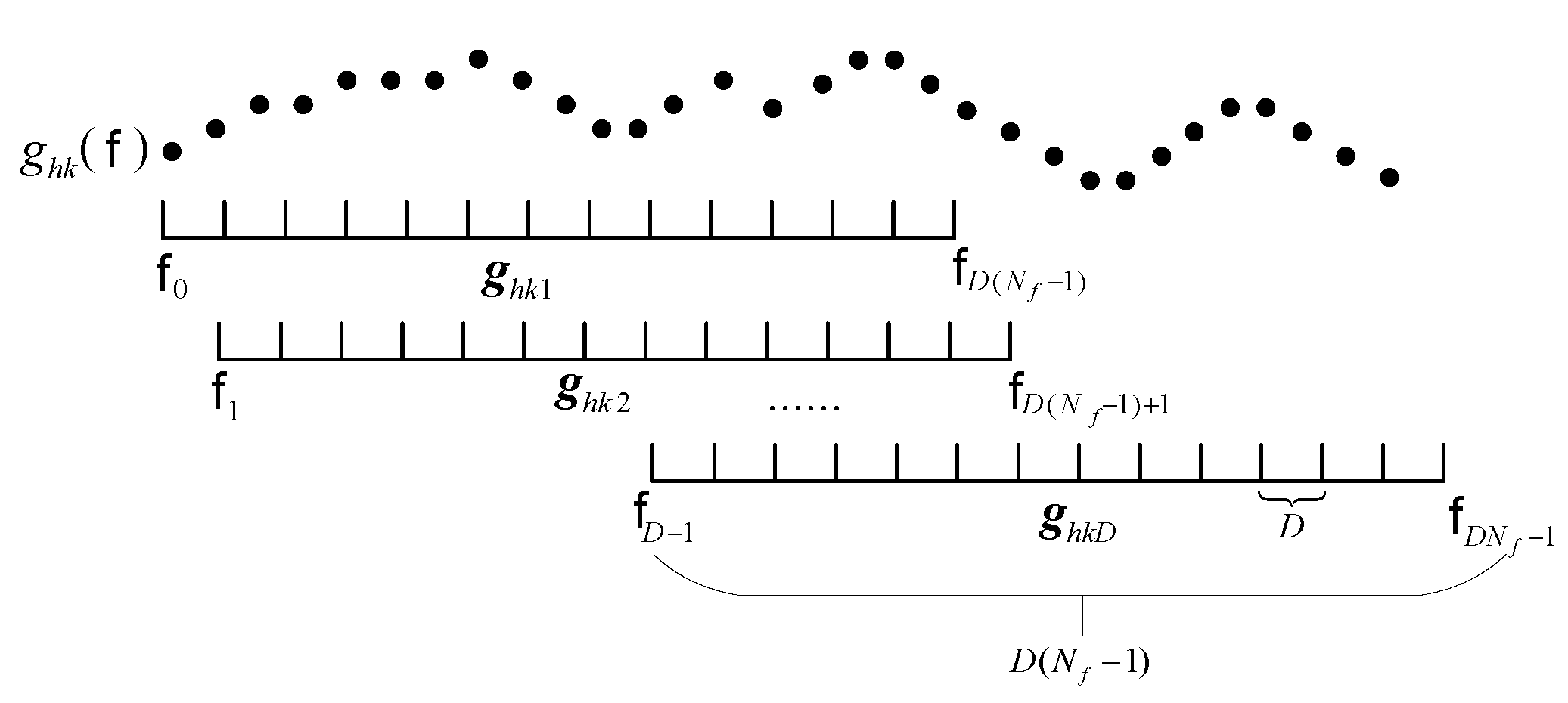

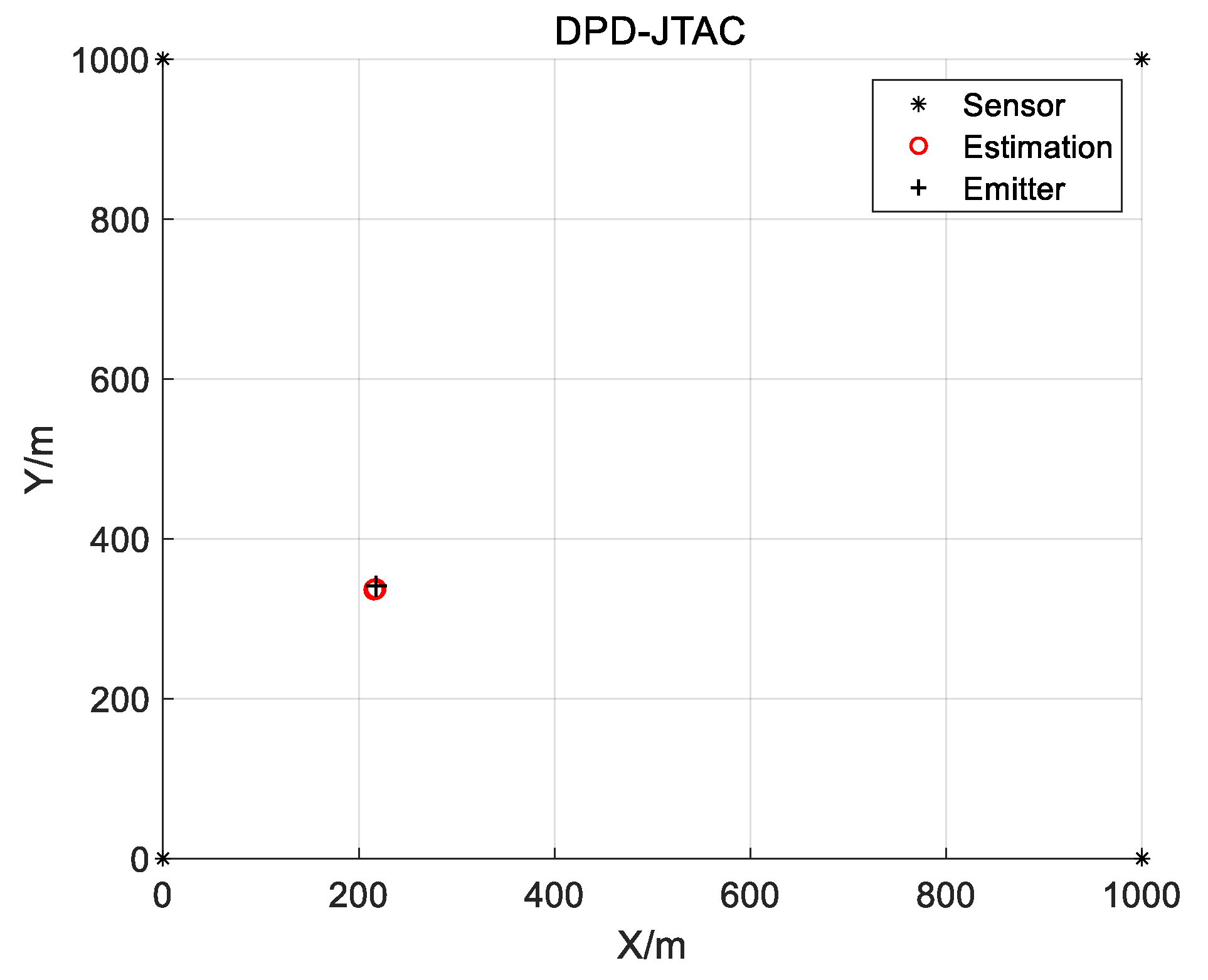

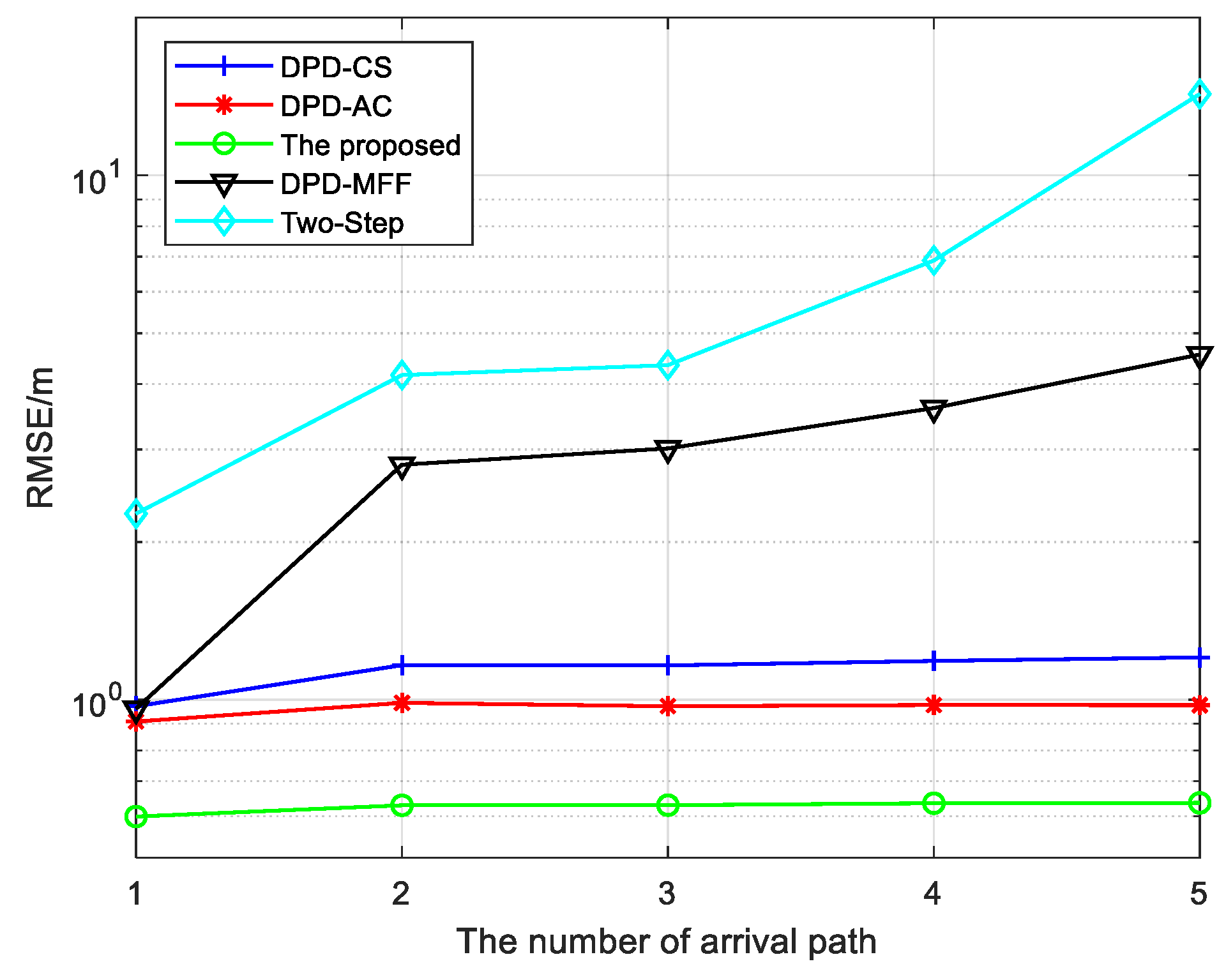
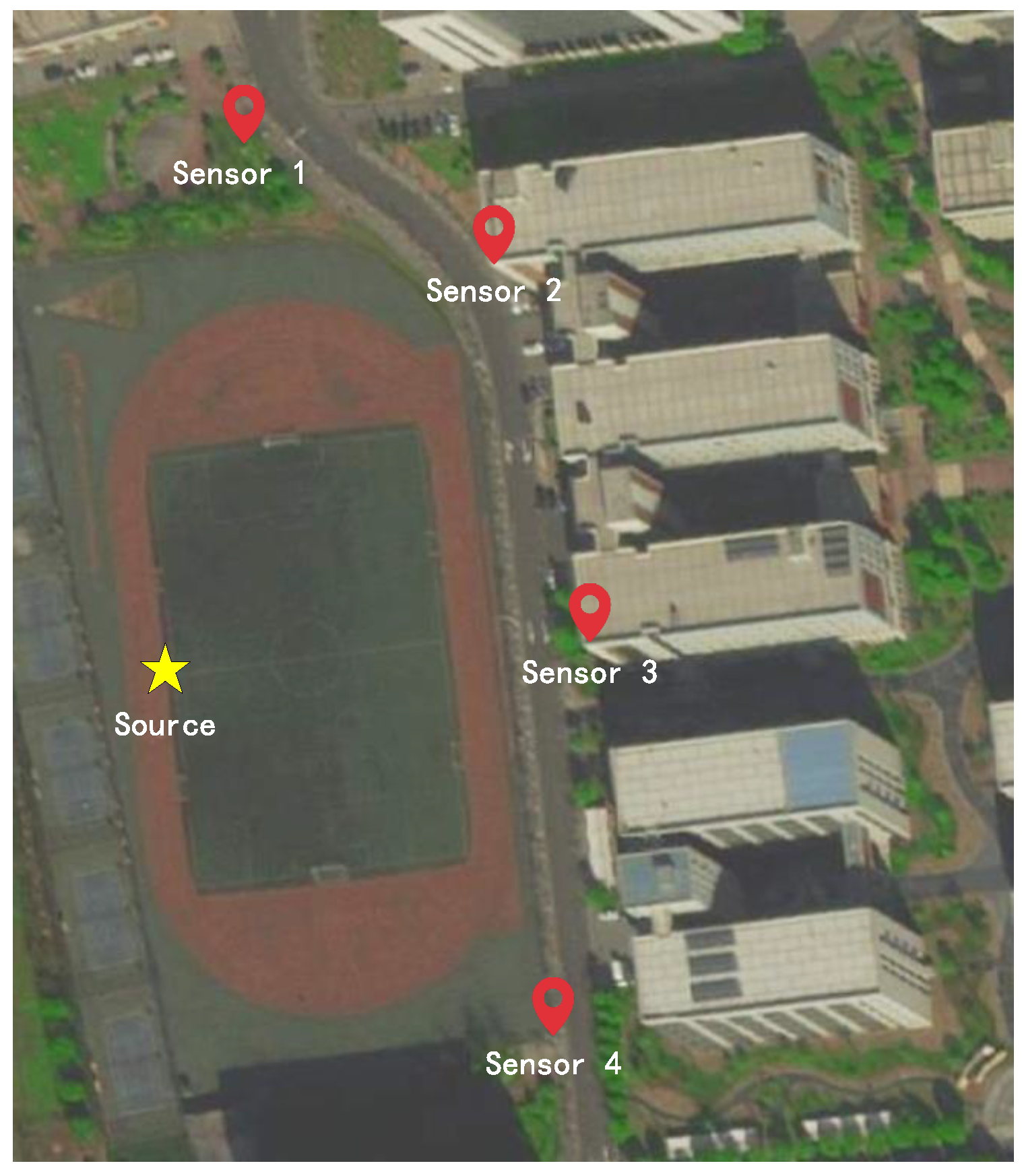
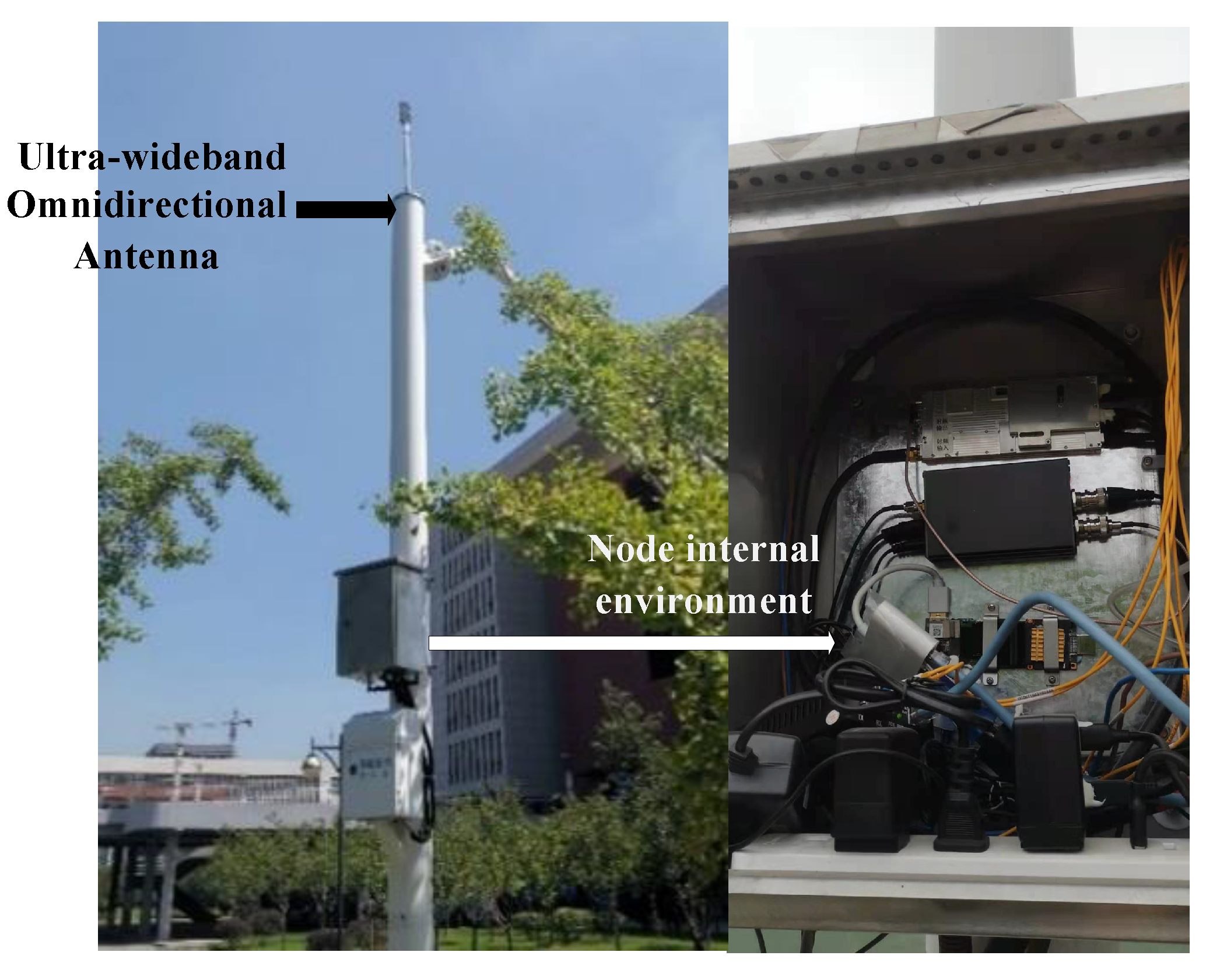



| Algorithm | Computational Complexity |
|---|---|
| Proposed | |
| DPD-AC | |
| DPD-CS | |
| DPD-MFF |
Disclaimer/Publisher’s Note: The statements, opinions and data contained in all publications are solely those of the individual author(s) and contributor(s) and not of MDPI and/or the editor(s). MDPI and/or the editor(s) disclaim responsibility for any injury to people or property resulting from any ideas, methods, instructions or products referred to in the content. |
© 2025 by the authors. Licensee MDPI, Basel, Switzerland. This article is an open access article distributed under the terms and conditions of the Creative Commons Attribution (CC BY) license (https://creativecommons.org/licenses/by/4.0/).
Share and Cite
Chai, H.; Yin, X.; Hu, H.; Zhang, X. Direct Position Determination of Wideband Source over Multipath Environment: Combining Taylor Expansion and Subspace Data Fusion in the Cross-Spectrum Domain. Sensors 2025, 25, 4967. https://doi.org/10.3390/s25164967
Chai H, Yin X, Hu H, Zhang X. Direct Position Determination of Wideband Source over Multipath Environment: Combining Taylor Expansion and Subspace Data Fusion in the Cross-Spectrum Domain. Sensors. 2025; 25(16):4967. https://doi.org/10.3390/s25164967
Chicago/Turabian StyleChai, Heng, Xinjian Yin, Hao Hu, and Xiaofei Zhang. 2025. "Direct Position Determination of Wideband Source over Multipath Environment: Combining Taylor Expansion and Subspace Data Fusion in the Cross-Spectrum Domain" Sensors 25, no. 16: 4967. https://doi.org/10.3390/s25164967
APA StyleChai, H., Yin, X., Hu, H., & Zhang, X. (2025). Direct Position Determination of Wideband Source over Multipath Environment: Combining Taylor Expansion and Subspace Data Fusion in the Cross-Spectrum Domain. Sensors, 25(16), 4967. https://doi.org/10.3390/s25164967








